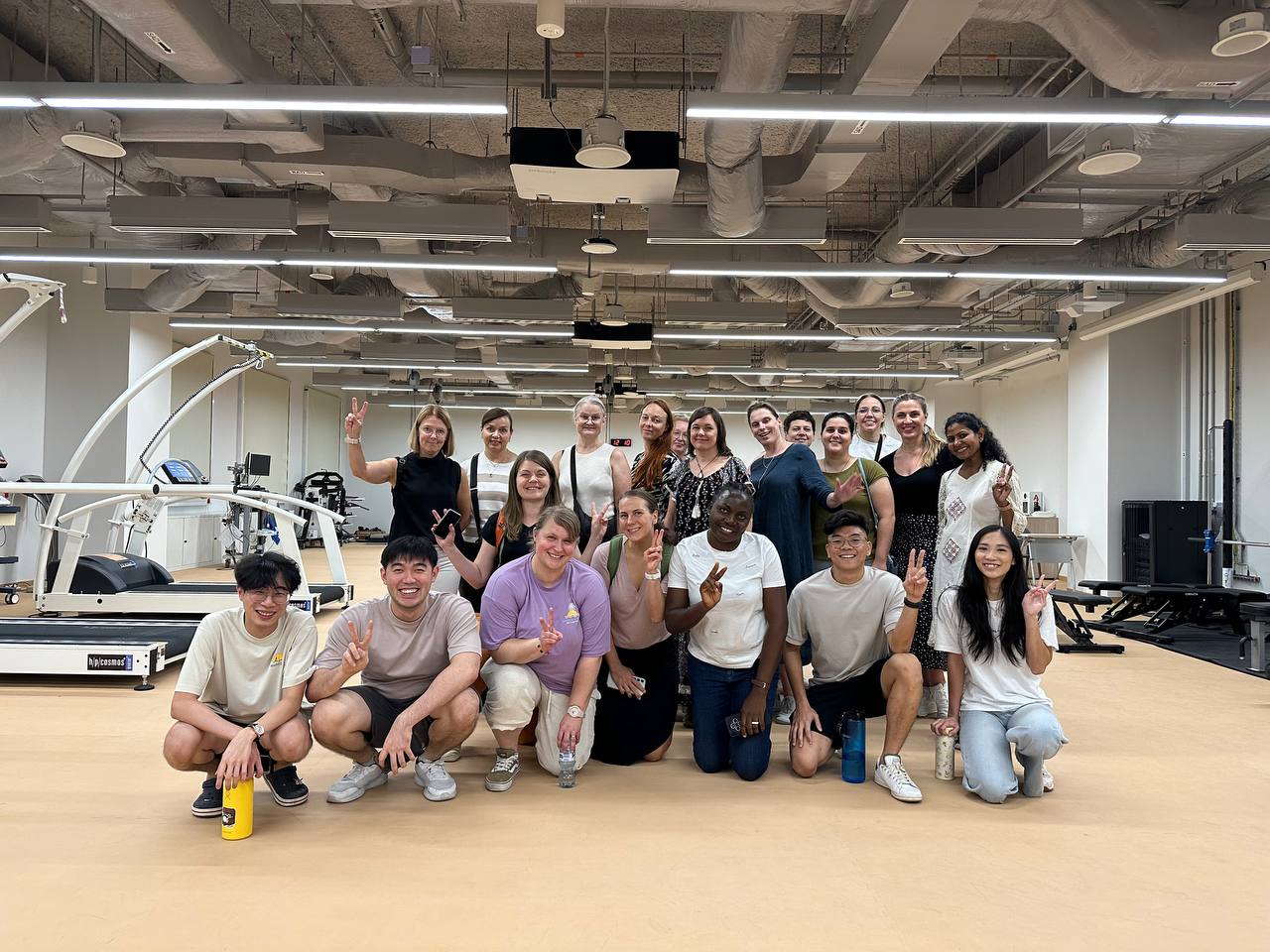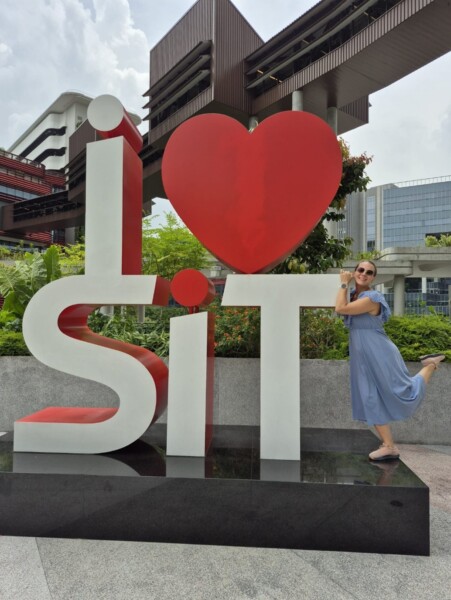
Savonia Article Pro: Active Aging through rehabilitation: Lessons from Singapore and Finland
Savonia Article Pro is a collection of multidisciplinary Savonia expertise on various topics.
This work is licensed under CC BY-SA 4.0
Introduction
This article is part of a blog series related to the Global and Sustainable Health (GOSH) project, funded by the Finnish National Agency for Education (TFK). The project has involved collaboration between four universities of applied sciences: Turku UAS, JAMK, Singapore Institute of Technology: University of Applied Sciences, and Savonia UAS. Together, they have developed a 5-credit study module titled Global and Sustainable Health. The course explores its main themes from the perspective of rehabilitation. It included an intensive week, which in autumn 2025 was held in Singapore. The blog articles describe students’ learning experiences, perspectives, and reflections during the intensive week.
This blog post was inspired by our visit to an elderly care centre in Singapore during the intensive week of the Global and Sustainable Health course. At Andrew’s Senior Care, we met older adults who participated in both structured rehabilitation and social day activities. The experience sparked reflections on how physiotherapy, rehabilitation and community engagement can promote active aging -concept that lies at the heart of sustainable health and wellbeing in an aging world.
Active Aging in a changing world
Population aging is one of the most significant global transformations of our century. According to Kirkwood and Austad (2000), aging is “the progressive loss of function accompanied by decreasing fertility and increasing mortality with advancing age.” As people live longer, chronic diseases such as cardiovascular conditions, COPD and stroke are becoming more common. However, these health challenges do not have to define later life. Through active living, rehabilitation and supportive environments, we can maintain functional ability and prevent or delay many of these conditions.
Active aging is about participation, purpose and empowerment. It reflects the ability of older people to continue engaging physically, socially and mentally in ways that enhance wellbeing and independence. In this sense, active aging is deeply connected to the goals of sustainable development. As the International Institute for Sustainable Development (2024) defines, sustainable development is “development that meets the needs of the present without compromising the ability of future generations to meet their own needs.” Promoting active aging supports this goal by strengthening health, reducing care dependency and sustaining intergenerational wellbeing.
Rehabilitation as a pathway to Active aging
The World Health Organization (WHO 2024) defines rehabilitation as “a set of interventions designed to optimize functioning and reduce disability in individuals with health conditions in interaction with their environment.” This definition emphasizes that rehabilitation is not only about recovery after illness but also about enabling people to live fulfilling lives at any age and in any condition.
Physiotherapy plays a central role in supporting active aging. Through individualized exercise programs, balance and strength training and health education, physiotherapists help older adults maintain mobility, prevent falls, and remain independent. Rehabilitation, therefore, becomes a proactive rather than a purely reactive process that supports participation in society rather than withdrawal from it.
Lessons from Singapore: The Power of Community and Volunteering
At Andrew’s Senior Care in Singapore, I was struck by how rehabilitation and social engagement were seamlessly combined. The centre was divided into two areas: one for physical rehabilitation and one focused on active aging activities. In the rehabilitation section, older adults received personalized physiotherapy sessions using gym-like equipment to improve muscle strength, coordination and balance. On the active aging side, the atmosphere was joyful and vibrant. Volunteers organized karaoke sessions, games, and group exercises and older adults could freely join daily activities. Many participants were still independent and mobile, finding joy and meaning in social connection and movement. What stood out most was the strong presence of volunteers who were not necessarily trained health professionals. This community-driven model reflects a collective approach to care that values social inclusion and shared responsibility for wellbeing. In Finland, such volunteer-based activity would be more difficult to organize, as most day centres require licensed healthcare personnel. Nevertheless, the Singaporean model demonstrates how broad community participation can enrich the lives of older adults and support sustainable healthcare.
Active Aging and Policy Challenges in Finland
In Finland, national health and ageing policies increasingly emphasize ageing in place is idea that older people should be able to live at home safely and independently for as long as possible. According to Sainio et al. (2025), this strategy shifts resources from institutional care toward home-based and community services, digital solutions and family caregiving. While the goal aligns with sustainability principles, there are clear challenges: fewer people now receive regular home care, many caregivers are themselves over 65, and digital services risk excluding older adults who are less technologically skilled.
At the same time, municipal funding for day centres and group activities has been repeatedly reduced, despite their proven role in maintaining functional capacity and preventing isolation. This creates a contradiction: although the policy framework promotes active and independent aging, the resources needed to achieve it are shrinking. To move forward, Finland must invest more consistently in accessible, community-based rehabilitation and physical activity programs and perhaps take inspiration from the participatory and volunteer-oriented approach we observed in Singapore.

Active Aging as Sustainable Health
Sustainability in healthcare also extends beyond individuals to the environment. As Padhy and Raj (2021) emphasize, environmentally sustainable physiotherapy involves connecting human health with environmental health for instance, by promoting outdoor physical activity, designing accessible green spaces and reducing the ecological footprint of healthcare facilities. Singapore’s elderly-friendly exercise parks are excellent examples of this integration, offering safe and pleasant environments that encourage physical activity as part of daily life.Active aging, therefore, is not only a health goal but a sustainability strategy which benefits individuals and communities.
Conclusion
Aging is inevitable, but decline is not. By promoting active lifestyles, community participation and lifelong rehabilitation, societies can empower older adults to live meaningful, independent and connected lives longer at home. Rehabilitation and physiotherapy are key enablers of this process. They foster not only movement and function but also confidence, belonging and purpose. As WHO (2024) reminds us, rehabilitation is a human right and an essential component of universal health coverage. Ensuring access to it in both Singapore and Finland is a vital step toward a sustainable and equitable future.
Keywords and Definitions
Active aging: The process of optimizing opportunities for health, participation, and security to enhance quality of life as people age.
Rehabilitation: Interventions that optimize functioning and reduce disability through interaction with one’s environment (WHO, 2024).
Sustainable health: Health promotion that meets current needs without compromising future generations’ wellbeing (Sustainable Development, 2024).
Ageing in place: The policy goal of enabling older adults to live at home safely and independently for as long as possible (Sainio et al., 2025).
Authors:
Merja Seppänen Physiotherapist, Master of Rehabilitation (student), Finland
Marja Äijö, PT, PhD Principal Lecturer of gerontology and rehabilitation, Savonia, University of Applied Sciences, Kuopio, Finland.
References:
Kirkwood, T. B. L., & Austad, S. N. (2000). Why do we age? Nature, 408: 233–238. Edunia-platform. 21.10.2025.
Padhy, G. K., & Raj, J. O. (2021). Environmental Physiotherapy and Global Issues. International Journal of Innovative Science and Research Technology, 6(10), 987–990. Edunia-platform. 21.10.2025.
Sainio, P., Holm, M., Hammar, T., Ilmarinen, K., Pennanen, M., A-M., Aalto, Sääksjärvi, K. & Koskinen, S. (2025). Iäkkäiden koettu toimintakyky ja avuntarve Suomessa – Terve Suomi -tutkimuksen tuloksia. Gerontologia 39(3), 2025. 159957-Artikkelin teksti-424686-1-10-20250925.pdf. 21.10.2025.
Seppänen, Merja 2025. The intensive week at the Singapore Institute of Technology provided a good opportunity to compare health strategies between countries. Picture. 17.10.2025. Singapore.
Sustainable Development. (2024). International Institute for Sustainable Development. Edunia-platform. 21.10.2025.
World Health Organization (WHO). (2024). Rehabilitation. Edunia-platform. 21.10.2025.